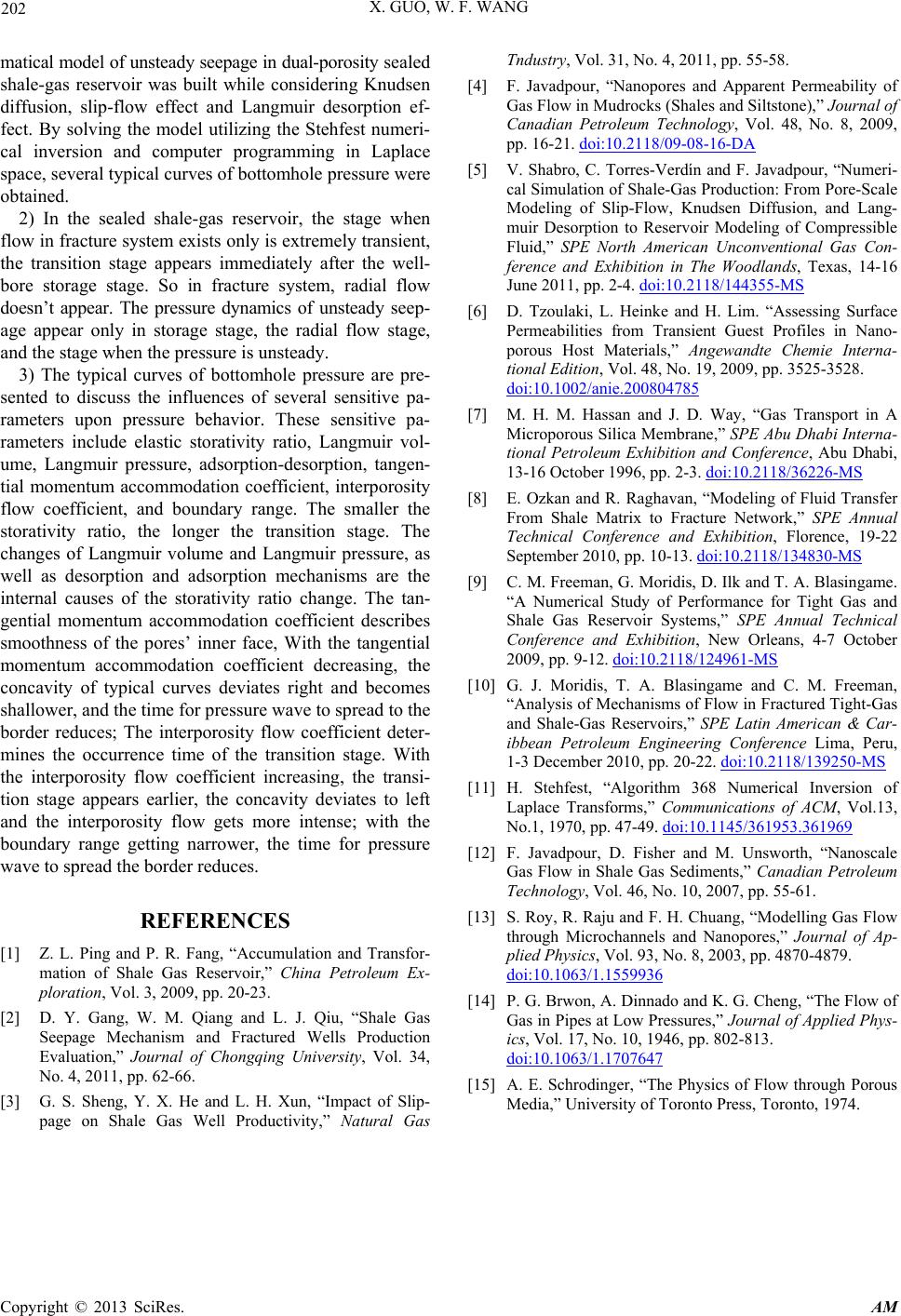
X. GUO, W. F. WANG
202
matical model of unsteady seepage in dual-porosity sealed
shale-gas reservoir was built while considering Knudsen
diffusion, slip-flow effect and Langmuir desorption ef-
fect. By solving the model utilizing the Stehfest numeri-
cal inversion and computer programming in Laplace
space, several typical curves of bottomhole pressure were
obtained.
2) In the sealed shale-gas reservoir, the stage when
flow in fracture system exists only is extremely transient,
the transition stage appears immediately after the well-
bore storage stage. So in fracture system, radial flow
doesn’t appear. The pressure dynamics of unsteady seep-
age appear only in storage stage, the radial flow stage,
and the stage when the pressure is unsteady.
3) The typical curves of bottomhole pressure are pre-
sented to discuss the influences of several sensitive pa-
rameters upon pressure behavior. These sensitive pa-
rameters include elastic storativity ratio, Langmuir vol-
ume, Langmuir pressure, adsorption-desorption, tangen-
tial momentum accommodation coefficient, interporosity
flow coefficient, and boundary range. The smaller the
storativity ratio, the longer the transition stage. The
changes of Langmuir volume and Langmuir pressure, as
well as desorption and adsorption mechanisms are the
internal causes of the storativity ratio change. The tan-
gential momentum accommodation coefficient describes
smoothness of the pores’ inner face, With the tangential
momentum accommodation coefficient decreasing, the
concavity of typical curves deviates right and becomes
shallower, and the time for pressure wave to spread to the
border reduces; The interporosity flow coefficient deter-
mines the occurrence time of the transition stage. With
the interporosity flow coefficient increasing, the transi-
tion stage appears earlier, the concavity deviates to left
and the interporosity flow gets more intense; with the
boundary range getting narrower, the time for pressure
wave to spread the border reduces.
REFERENCES
[1] Z. L. Ping and P. R. Fang, “Accumulation and Transfor-
mation of Shale Gas Reservoir,” China Petroleum Ex-
ploration, Vol. 3, 2009, pp. 20-23.
[2] D. Y. Gang, W. M. Qiang and L. J. Qiu, “Shale Gas
Seepage Mechanism and Fractured Wells Production
Evaluation,” Journal of Chongqing University, Vol. 34,
No. 4, 2011, pp. 62-66.
[3] G. S. Sheng, Y. X. He and L. H. Xun, “Impact of Slip-
page on Shale Gas Well Productivity,” Natural Gas
Tndustry, Vol. 31, No. 4, 2011, pp. 55-58.
[4] F. Javadpour, “Nanopores and Apparent Permeability of
Gas Flow in Mudrocks (Shales and Siltstone),” Journal of
Canadian Petroleum Technology, Vol. 48, No. 8, 2009,
pp. 16-21. doi:10.2118/09-08-16-DA
[5] V. Shabro, C. Torres-Verdín and F. Javadpour, “Numeri-
cal Simulation of Shale-Gas Production: From Pore-Scale
Modeling of Slip-Flow, Knudsen Diffusion, and Lang-
muir Desorption to Reservoir Modeling of Compressible
Fluid,” SPE North American Unconventional Gas Con-
ference and Exhibition in The Woodlands, Texas, 14-16
June 2011, pp. 2-4. doi:10.2118/144355-MS
[6] D. Tzoulaki, L. Heinke and H. Lim. “Assessing Surface
Permeabilities from Transient Guest Profiles in Nano-
porous Host Materials,” Angewandte Chemie Interna-
tional Edition, Vol. 48, No. 19, 2009, pp. 3525-3528.
doi:10.1002/anie.200804785
[7] M. H. M. Hassan and J. D. Way, “Gas Transport in A
Microporous Silica Membrane,” SPE Abu Dhabi Interna-
tional Petroleum Exhibition and Conference, Abu Dhabi,
13-16 October 1996, pp. 2-3. doi:10.2118/36226-MS
[8] E. Ozkan and R. Raghavan, “Modeling of Fluid Transfer
From Shale Matrix to Fracture Network,” SPE Annual
Technical Conference and Exhibition, Florence, 19-22
September 2010, pp. 10-13. doi:10.2118/134830-MS
[9] C. M. Freeman, G. Moridis, D. Ilk and T. A. Blasingame.
“A Numerical Study of Performance for Tight Gas and
Shale Gas Reservoir Systems,” SPE Annual Technical
Conference and Exhibition, New Orleans, 4-7 October
2009, pp. 9-12. doi:10.2118/124961-MS
[10] G. J. Moridis, T. A. Blasingame and C. M. Freeman,
“Analysis of Mechanisms of Flow in Fractured Tight-Gas
and Shale-Gas Reservoirs,” SPE Latin American & Car-
ibbean Petroleum Engineering Conference Lima, Peru,
1-3 December 2010, pp. 20-22. doi:10.2118/139250-MS
[11] H. Stehfest, “Algorithm 368 Numerical Inversion of
Laplace Transforms,” Communications of ACM, Vol.13,
No.1, 1970, pp. 47-49. doi:10.1145/361953.361969
[12] F. Javadpour, D. Fisher and M. Unsworth, “Nanoscale
Gas Flow in Shale Gas Sediments,” Canadian Petroleum
Technology, Vol. 46, No. 10, 2007, pp. 55-61.
[13] S. Roy, R. Raju and F. H. Chuang, “Modelling Gas Flow
through Microchannels and Nanopores,” Journal of Ap-
plied Physics, Vol. 93, No. 8, 2003, pp. 4870-4879.
doi:10.1063/1.1559936
[14] P. G. Brwon, A. Dinnado and K. G. Cheng, “The Flow of
Gas in Pipes at Low Pressures,” Journal of Applied Phys-
ics, Vol. 17, No. 10, 1946, pp. 802-813.
doi:10.1063/1.1707647
[15] A. E. Schrodinger, “The Physics of Flow through Porous
Media,” University of Toronto Press, Toronto, 1974.
Copyright © 2013 SciRes. AM